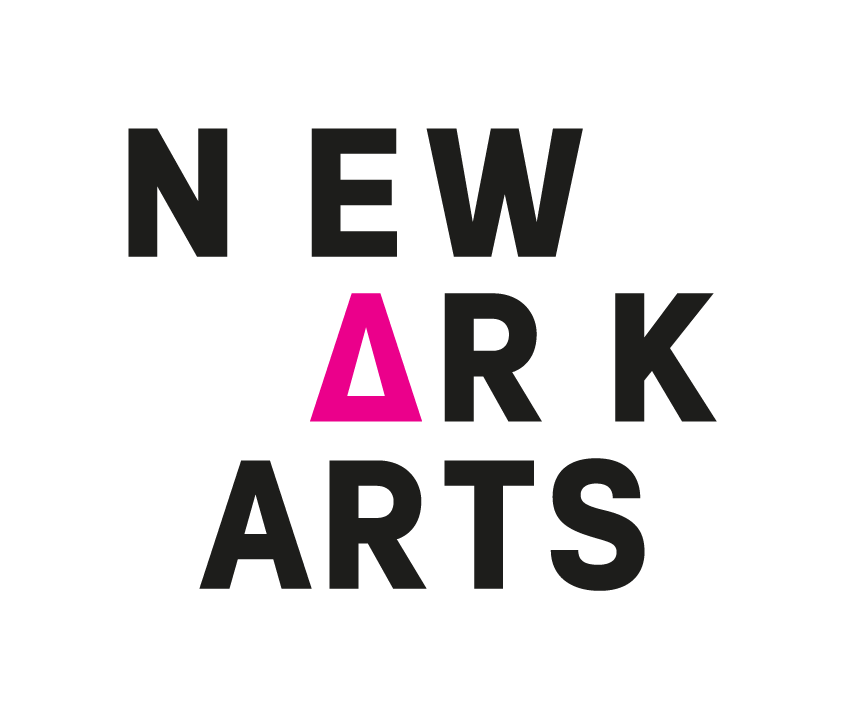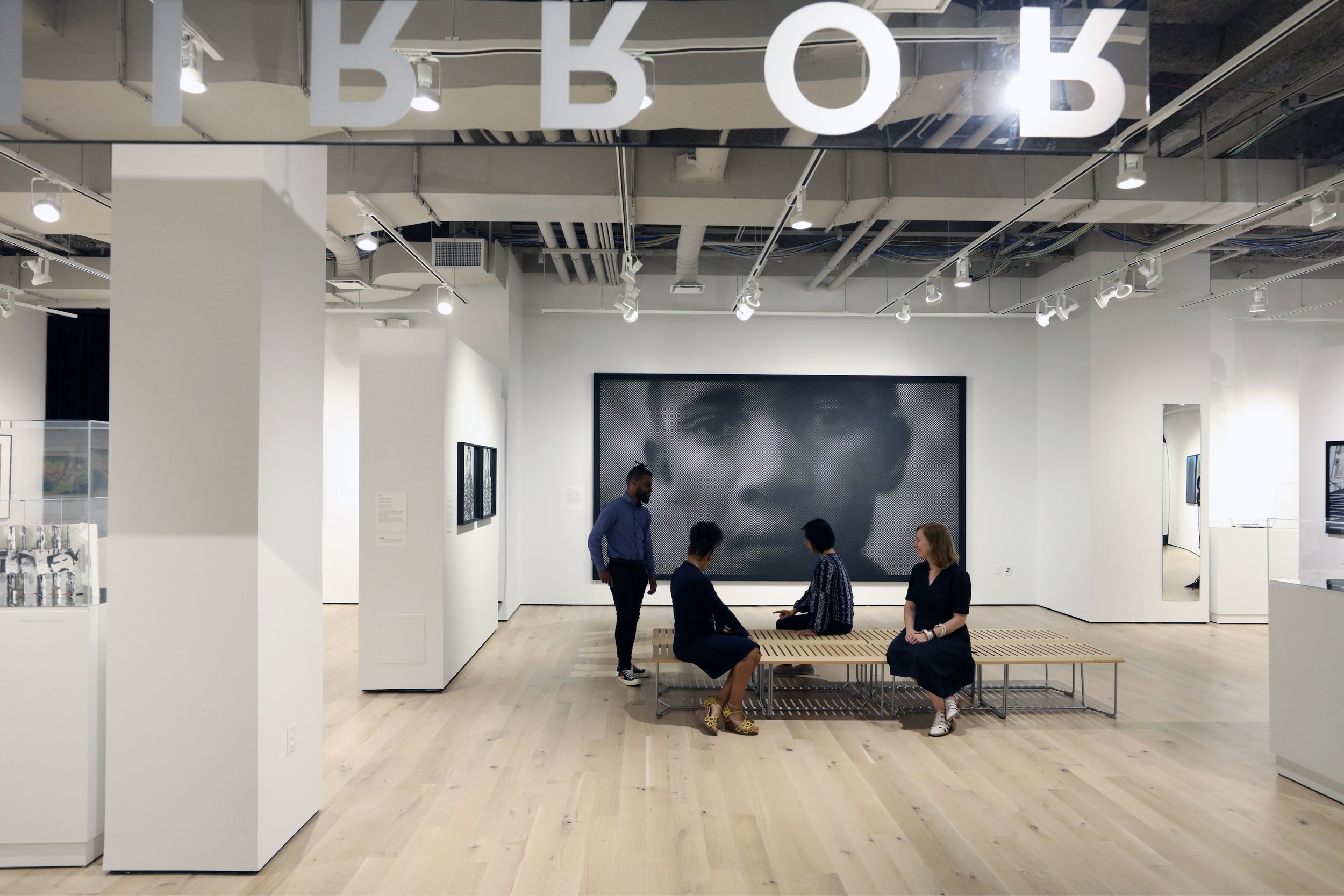PAUL ROBESON GALLERIES
PRG TEAM TALK ON COMBINING CURRICULUM WITH COMMUNITY
Director & Chief Curator Anonda Bell, Associate Director of Programs Caren King Choi, Program Assitant Amalia Mallard and Administrative Assistant Bryant Lebron | Photo Credit: Anthony Alvarez
PAUL ROBESON WAS AN IMPORTANT FIGURE IN AMERICAN HISTORY; NOT ONLY WAS HE A DISTINGUISHED RUTGERS ALUM, ACTOR AND PUBLIC FIGURE; BUT ALSO, HE WAS AN IMPORTANT CIVIL RIGHTS ACTIVIST. WHAT ARE SOME SIGNIFICANT WAYS IN WHICH THE GALLERY CONTINUES TO UPHOLD ITS NAMESAKE’S LEGACY?
Amalia Mallard, Program Assistant: The Paul Robeson Galleries upholds the legacy through exhibits and programs. Paul Robeson’s political activism predates the civil rights movement. He was a trailblazer and displayed great courage by asserting his humanity, and that of African Americans through his art. He was both outspoken and treated as an outcast, which reminds us that each voice matters – whether solo or in a chorus. Robeson’s example as a global citizen encourages the spirit of collaboration and partnership. As such, the gallery represents a broad community and everybody gets a seat at the table. The gallery empowers artists and engages visitors to consider various aesthetic, political, and social attitudes and values.
IN RECENT YEARS PRG HAS EXPANDED SIGNIFICANTLY, FROM SMALLER GALLERIES, TO A BEAUTIFUL NEW SPACE AT EXPRESS NEWARK IN THE HAHNE’S BUILDING. PLEASE TELL US A BIT ABOUT THIS PROCESS AND SOME OF THE GOALS THE GALLERY HAD IN EXPANDING?
Joseph Sabatino, Head Preparator: I’ve collaborated with PRG for over ten years as an artist, arts educator, freelance preparator and most recently – a full time staff member of Express Newark. Having first-hand exposure to the systematic progressions, I’ve been fortunate to experience the crucial expansion in our outreach to both the students and overall, local, arts community. The developments that continue to spread geographically nearby and hopefully beyond our walls are only validated by our core goals that have been steady since the onset. The natural evolution merging public awareness, education and creativity would not occur without the collaboration of sought out artists, cutting edge artwork, voluminous spaces and relevant content of our exhibition roster. Whether casually walking the corridors of campus grounds or engaging in the communal dispersion of diversified, contemporary works in a modern pentagon-like space; the partnership with the general public will remain strong. With the recent addition of our fresh, state of the art facility and gallery, PRG at Express Newark is sure to influence and engage the region as our growth simultaneously looks to inspire.
WHAT IS THE PROCESS FOR SELECTING THE THEMES YOU ADDRESS IN YOUR EXHIBITIONS?
Jacqueline Mabey, Curatorial Assistant: PRG’s program aims to reckon with our culture by approaching it from a variety of angles. Curated by both PRG staff and by members of the community, the themes range from the topical matters, referencing contemporary social and political events, as well as more universal subjects, like food or the natural world.
WHAT HAVE BEEN SOME OF THE CHALLENGES IN CREATING EXHIBITIONS ACROSS SO MANY SPACES THAT ADDRESS SUCH A DIVERSE AUDIENCE?
Anonda Bell, Director & Chief Curator: I believe that the challenges that the PRG faces are less to do with the logistical concerns about how to maintain multiple physical sites across the Rutgers University Campus and more to do with broader issues for the arts within society. Artists endeavor to live imaginative and sustainable lives within an environment that is not always nurturing. Creativity is certainly not valued in the way that other skills are. Financial remuneration rarely is substantial enough for an individual to live from their art practice alone. The importance of creativity within an education context is widely recognized, yet STEM programs are favored within schools. Research has shown that education we provide for future generations should be to foster creative ways of thinking and problem solving, rather than rote learning of facts. The world is changing so rapidly that the ability to nurture agile minds should be the sign of success. Paul Robeson once said, “Artists are the gatekeepers of the truth.” The arts have a role to play in society which does not just reflect the status quo. Art may instead be speculative and generative. It may shape the way that we exist, in states of plurality and diversity. The Robeson Galleries does not aspire to produce definitive exhaustive or encyclopedic exhibitions. We are instead interested in working with many creative individuals and organizations. We are committed to creating programs which reflect multiple, simultaneous truths.
RUTGERS IS A RESEARCH-BASED UNIVERSITY: TELL US A LITTLE BIT ABOUT RELATIONSHIP BETWEEN CURRICULUM AND YOUR EXHIBITIONS.
Caren King Choi, Associate Director of Programs: Although we’re a visual arts gallery, we have a strong interdisciplinary bent and are always interested in pursuing ideas that go beyond the realm of the art world—we care deeply about relevance and the potential for art to activate ideas. Being part of Rutgers gives us lots of opportunities to connect with people who are interested in exploring difficult questions in many realms: science, sociology, politics, mathematics, and the humanities. Sometimes we collaborate directly with departments on exhibitions, such as when we partnered with the Center for Migration and the Global City to present “Crossing the BLVD: Strangers, Neighbors, Aliens in a New America”; or when we showed an exhibit of student work called “From Rebellion to Review Board: Fighting for Police Accountability in Newark.” Other times the relationship is indirect, but we always have scholarship and collaboration in mind. For example, when we did a show about illness and the body (What Cannot Be Cured Must Be Endured, 2012) we reached out to UMDNJ and the nursing school. We frequently invite artists to give talks to classes in different disciplines because the artist’s perspective can help illuminate a subject in a new way.
It should go without saying that we’re also well connected to the Department of Arts, Culture & Media here at Rutgers. We created a series of programs called Art Biz that teaches professional skills to emerging artists. The series has become a part of the Fine Arts senior thesis curriculum and prepares art students for the world beyond.
EXPRESS NEWARK IS A FACET OF RUTGERS THAT IS ROOTED IN COMMUNITY ENGAGEMENT: HOW IS THE NEW PRG SITE CULTIVATED COMMUNITY-ORIENTED EXHIBITION PROGRAM?
Bryant Lebron, Administrative Assistant: Community organization is one of the staples of the Paul Robeson Galleries’ mission and with Express Newark that mission will continue. Through collaborative efforts, exhibition programming is not just for the community but by the community alongside native Newark Artists and Educators.

